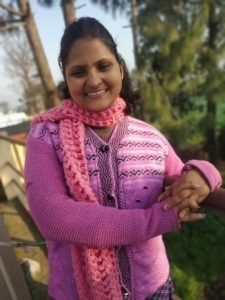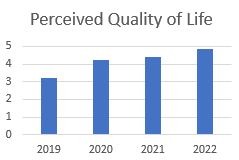Across India, advocacy groups, professionals, civil society groups, NGOs, and government are working in many different ways toward dignified and full lives for people with disabilities. Although the ways of moving forward may differ, most share this goal. What would it look like if the fullness of life were to be measured? Many indexes have been tested and tried over the course of evaluating the well-being of a population, from the Happiness Index to Human Development Index. Each paints a portrait of large-scale well-being for an entire population, very useful in many ways.
 Those large -scale indices are essential in seeing national and global, even regional change, but what do they tell us about Ms. Kiran’s life? Born with a developmental disability into a difficult family circumstance, she landed in a series of government institutions as a child and did not find freedom until she was a young adult. She was struck by many wounds throughout her young life, each of which is hard to quantify in graph or chart. Those who assisted her to leave the institution and start afresh knew they had to capture the changes in her life, document the transformation, bring it to the attention of those working toward alternatives to government institutions. Seeing is believing, but without concrete data backing up that change, programs to liberate people from institutions will be on shaky ground, and Kiran’s future is not assured. Not everyone will remember the shy, quiet young woman, trying to keep a low profile in a place of chaos and, sometimes, brutality. Not everyone will see her today, confident, skilled, independent, and so competent, as she has taken her place as a valued member of her community.
Those large -scale indices are essential in seeing national and global, even regional change, but what do they tell us about Ms. Kiran’s life? Born with a developmental disability into a difficult family circumstance, she landed in a series of government institutions as a child and did not find freedom until she was a young adult. She was struck by many wounds throughout her young life, each of which is hard to quantify in graph or chart. Those who assisted her to leave the institution and start afresh knew they had to capture the changes in her life, document the transformation, bring it to the attention of those working toward alternatives to government institutions. Seeing is believing, but without concrete data backing up that change, programs to liberate people from institutions will be on shaky ground, and Kiran’s future is not assured. Not everyone will remember the shy, quiet young woman, trying to keep a low profile in a place of chaos and, sometimes, brutality. Not everyone will see her today, confident, skilled, independent, and so competent, as she has taken her place as a valued member of her community.
The data says this: Kiran has experienced an enormous increase in integrative activities since she began living a typical community life.

What does this really mean? She planned and experienced her first vacation ever. She regularly walks to the local shops, went swimming in a local pool, hosted a visit at her home from her sister, and opened a bank account. Each of these new experiences gave her self-assurance, pride in her life, and anticipation and expectation that tomorrow will no doubt bring unexpected possibilities.
Her independence and skill level has increased by nearly 4% across multiple domains.

What does this really mean? Kiran travels the lanes of her neighborhood independently. She budgets her money with care, cooks the food she likes, and saves for the things she would like to have that will improve her life. Most recently, this meant a smart phone, which has opened the world to her. With independence comes growth, life, change and more opportunity. Kiran believes in herself.
Her perceived Quality of Life has improved by 34%.

What does this really mean? Kiran is pleased with her life, and appreciates the friends that she has, the life that she leads, and the home that she lives in. She has an overall sense of satisfaction with her life that shows in the way she looks, acts, and interacts. She feels that she matters – to her friends, to her community, and maybe even to the world.
Yes, we can measure many things about people’s lives when we undertake to help people improve their circumstances. Indeed, we have an obligation to. However, we should keep in mind that what that change really means in the life of a unique individual person should be brought into the light, reckoned with, celebrated, defended, and protected.


 Those large -scale indices are essential in seeing national and global, even regional change, but what do they tell us about Ms. Kiran’s life? Born with a developmental disability into a difficult family circumstance, she landed in a series of government institutions as a child and did not find freedom until she was a young adult. She was struck by many wounds throughout her young life, each of which is hard to quantify in graph or chart. Those who assisted her to leave the institution and start afresh knew they had to capture the changes in her life, document the transformation, bring it to the attention of those working toward alternatives to government institutions. Seeing is believing, but without concrete data backing up that change, programs to liberate people from institutions will be on shaky ground, and Kiran’s future is not assured. Not everyone will remember the shy, quiet young woman, trying to keep a low profile in a place of chaos and, sometimes, brutality. Not everyone will see her today, confident, skilled, independent, and so competent, as she has taken her place as a valued member of her community.
Those large -scale indices are essential in seeing national and global, even regional change, but what do they tell us about Ms. Kiran’s life? Born with a developmental disability into a difficult family circumstance, she landed in a series of government institutions as a child and did not find freedom until she was a young adult. She was struck by many wounds throughout her young life, each of which is hard to quantify in graph or chart. Those who assisted her to leave the institution and start afresh knew they had to capture the changes in her life, document the transformation, bring it to the attention of those working toward alternatives to government institutions. Seeing is believing, but without concrete data backing up that change, programs to liberate people from institutions will be on shaky ground, and Kiran’s future is not assured. Not everyone will remember the shy, quiet young woman, trying to keep a low profile in a place of chaos and, sometimes, brutality. Not everyone will see her today, confident, skilled, independent, and so competent, as she has taken her place as a valued member of her community.

